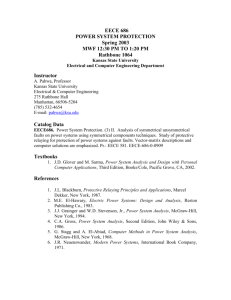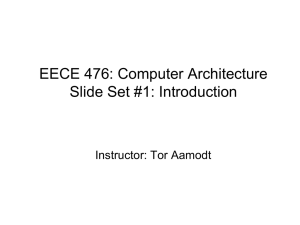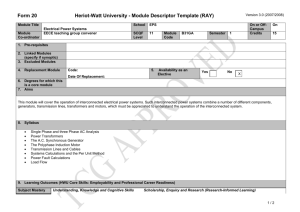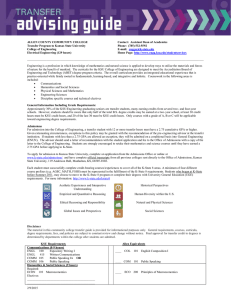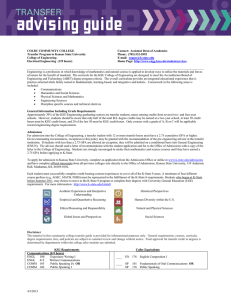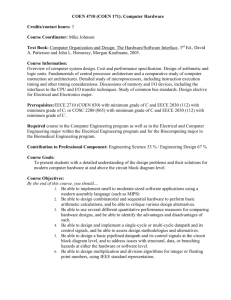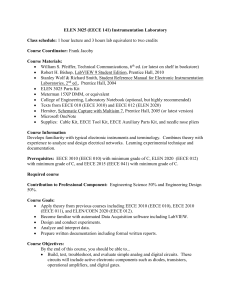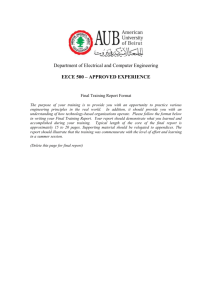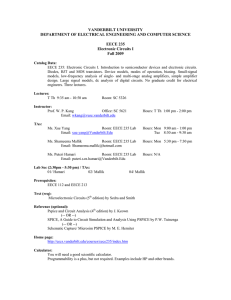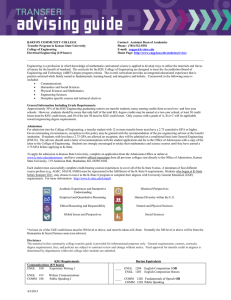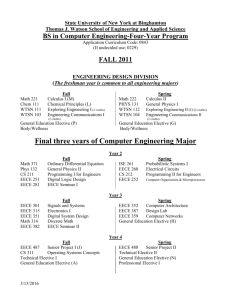EECE 685 - Electrical and Computer Engineering | Kansas State
advertisement
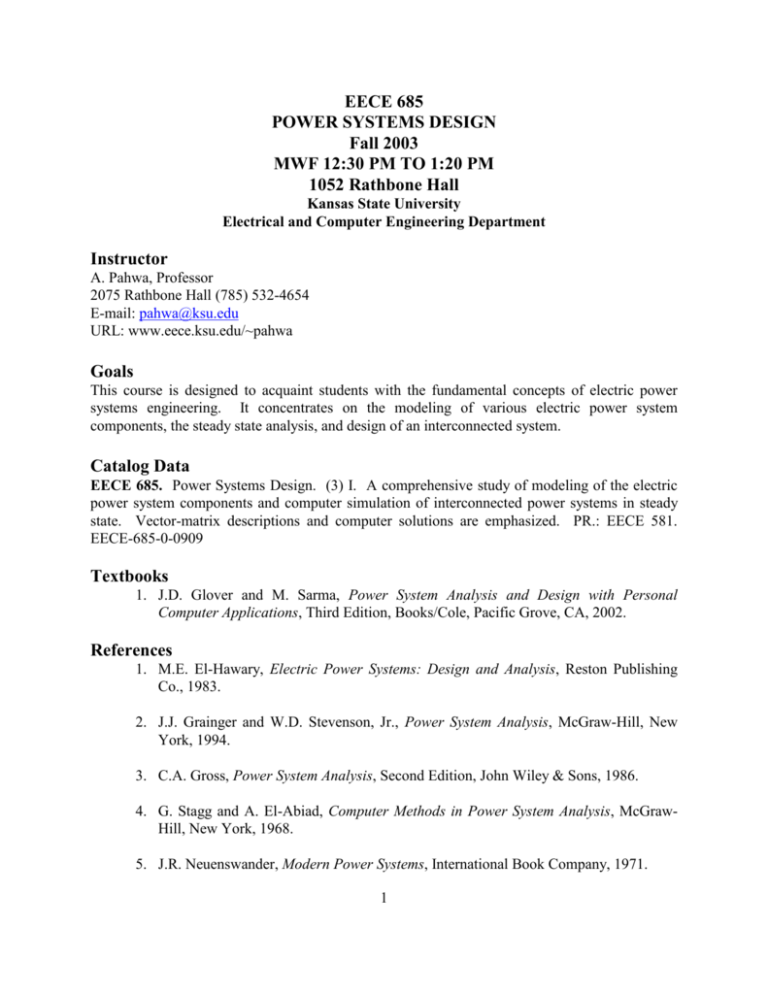
EECE 685 POWER SYSTEMS DESIGN Fall 2003 MWF 12:30 PM TO 1:20 PM 1052 Rathbone Hall Kansas State University Electrical and Computer Engineering Department Instructor A. Pahwa, Professor 2075 Rathbone Hall (785) 532-4654 E-mail: pahwa@ksu.edu URL: www.eece.ksu.edu/~pahwa Goals This course is designed to acquaint students with the fundamental concepts of electric power systems engineering. It concentrates on the modeling of various electric power system components, the steady state analysis, and design of an interconnected system. Catalog Data EECE 685. Power Systems Design. (3) I. A comprehensive study of modeling of the electric power system components and computer simulation of interconnected power systems in steady state. Vector-matrix descriptions and computer solutions are emphasized. PR.: EECE 581. EECE-685-0-0909 Textbooks 1. J.D. Glover and M. Sarma, Power System Analysis and Design with Personal Computer Applications, Third Edition, Books/Cole, Pacific Grove, CA, 2002. References 1. M.E. El-Hawary, Electric Power Systems: Design and Analysis, Reston Publishing Co., 1983. 2. J.J. Grainger and W.D. Stevenson, Jr., Power System Analysis, McGraw-Hill, New York, 1994. 3. C.A. Gross, Power System Analysis, Second Edition, John Wiley & Sons, 1986. 4. G. Stagg and A. El-Abiad, Computer Methods in Power System Analysis, McGrawHill, New York, 1968. 5. J.R. Neuenswander, Modern Power Systems, International Book Company, 1971. 1 Prerequisites EECE 581 Energy Conversion I. Prerequisites by topic: • AC steady state analysis in phasor domain • Power and energy concept • Basic three phase circuits • Transformer modeling • Synchronous machine modeling • Matrix fundamentals Course Outline Introduction ................................................. Chapter 1 Optimal Fuel Mix Analysis ...................... Supplement Single Phase AC Circuits ............................ Chapter 2 Three Phase AC Circuits ............................. Chapter 2 Transformer Modeling ................................ Chapter 3 Per Unit System .......................................... Chapter 3 Three Phase Transformers .......................... Chapter 3 Transmission-Line Models ......................... Chapter 5 Load Flow ................................................... Chapter 6 Transmission-Line Parameters .................... Chapter 4 Suggested Problems Chapter Chapter Chapter Chapter Chapter 2 3 5 6 4 5, 7 – 10, 12 – 20, 22 – 26, 32 – 38, 40 2, 14, 17 – 19, 21 – 23, 25 – 30, 32 – 34 1, 2, 8, 9, 11, 12, 20, 22, 26 – 28, 33, 35 – 38 8 – 12, 22 – 27, 29 – 31, 33 1 – 3, 9 – 14, 27 – 30 Computer Usage Computer programs for load-flow and for determination of line constants of transmission lines will be used in this course. Several programs are available free of charge from various sources. Information on these programs will be provided in the class. Design Project A project relating to design of an interconnected power system will be assigned for this class. The students will be required to submit progress reports and a formal report after completion of the project. 2 Exams There will be two semester exams and a final exam. The dates of the exams are mentioned elsewhere in this handout. Grading The grades will be decided on the following basis: Exam #1 Exam #2 Final Exam Design Project Homework 100 points 100 points 100 points 100 points 50 points Scores of 90, 80, 70, and 60 will be used as a guideline for determining A, B, C and D grades. However, the grades may drop by a few points depending on the nature of the exams. Important Dates August October October November December December 20 1 13 5 26, 28 10 12 18 Classes start Exam #1 No Class (Fall Break) Exam #2 No class (Thanksgiving) Last day of class Preparation Day Final Exam (4:10 PM to 6:00 PM) Email A listserve (eece685-l) will be setup for all communications related to this class. All the students must use it for communication related to the class as much as possible. However, for personal matters you may send the email directly to me. Office Hours MWF 11:30 AM to 12:20 PM or by appointment Please try to see me for any difficulties during my office hours. If you have a conflict or an emergency, please make an appointment. 3 Minimum Standards for Student Papers Most engineering organizations have internal standards for their drawings and documentation. The purpose of these is to facilitate the exchange of information and to reduce unnecessary work. The following simple standards will apply to all student papers including homework, quizzes, and computer programs. 1. Student’s name, instructor’s name, course title, date, and page number to appear on the top of the first page. Include a title when relevant. 2. Student’s name, date, and page number to appear on all other pages. 3. Cut and trim all computer printouts to proper size. 4. If the pages require stapling, staple in upper left corner. 5. Use engineering paper for all work unless requested otherwise. Padmaster No. 34520 with the faint blue grid makes excellent photocopies. Use one side of the paper only, unless specifically instructed otherwise. 6. Use a straight edge for all straight lines and a logic template for all symbols. 7. Work logically and systematically through your problems, show all the important steps. Answers without supporting work are not acceptable. 8. Box intermediate and final results giving all dimensions or units. Example: 9. SLEW RATE = 100 Volts/Second For design problems, when asked to explain how a particular system operates, you are expected to provide the following: 9.1 A block diagram or circuit diagram; 9.2 Description of system operation with relevant equations; 9.3 Waveforms wherever possible; 9.4 Algorithm in English if applicable. 4
